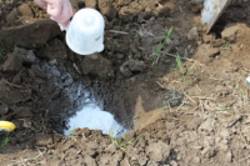With planting delayed briefly due to rain, it is the perfect time to get out and set up some wireworm bait stations. Soil temperatures are quite warm now and recent University of Guelph Ridgetown Campus research has found that spring is the better time to successfully bait for wireworms. Spring time is likely better in part because the soil is still moist, ensuring that the bait actually does its job. Soil conditions that are too dry prevents the bait ingredients from fermenting and releasing CO2 which is what the wireworms are attracted to. There is of course one exception….you don’t want to dig baits in really saturated soils. The bait station will either dry like cement or the water will flood the bait entirely and make it useless. So wait a few days if there are puddles in the field before setting them up.
If you need to complete a pest assessment report, or just want to know what the wireworm activity is like in your field, here is how to do it. There are instructions below if you just want to dig for grubs or wireworms without using bait stations.

To set up wireworm baits:
1. Dig a hole approx 15 cm by 15 cm by 15 cm deep
2.Place a cup of bait in the bottom of the hole. Baits can be made of:
- 1 cup of all-purpose flour – moisten with some water once placed in the hole or
- 1 cup of equal parts of untreated corn, wheat and beans that has been soaked overnight.
3.Break up any clumps of soil that was dug up and mound the soil over the bait.
4.To deter predators and keep the bait moist and warm, place a black plastic bag over the bait station and cover the corners of the plastic with soil so that it doesn’t blow away.
5.Place a flag at the station so you can find it again.
6.Return 7 to 10 days later to dig up the bait. Break up the bait to search for the presence of wireworms.
Do this for at least 5 locations in the plot, each bait station being at least 10 metres apart from each other. Experience has taught us that predators like to pull up the baits so place more than is required to ensure that there are five still left to assess.
To dig for wireworms or grubs:
1.Dig a hole approximately 30 cm by 30 cm wide to about 7 to 10 cm deep.
2.Sift through the soil that was removed from the hole, breaking up any larger clumps.
3.Search and record any wireworms or grubs found in the hole or the soil that was removed.
Do this digging method for at least 5 locations in the plot, each location being at least 10 metres apart from each other.
Remember, don’t confuse millipedes for wireworms. Click here to see the differences.
For access specifically to NNI treated corn or soybean seed, a Soil Inspection Pest Assessment is required – For every plot 100 acre or less, baits or digging will need to be conducted in 5 areas of the field. Look for higher risk areas of the fields to focus your scouting efforts, though each of the 5 scouting areas need to be 10 metres apart from each other. High risk areas of the field include sandy or silty areas of the field, especially knolls, areas where grassy weeds are prevalent, or in areas where gaps in the stand have been noticed in the past.
The threshold to purchase and use (plant) neonicotinoid treated corn or soybean seed is an average of 1 wireworm or 2 grubs averaged over 5 scouting locations.
If this threshold is met, fill out either the paper version of the form here: Inspection of Soil – Pest Assessment Report or the NEW – ONLINE PEST ASSESSMENT REPORT OPTION! These forms are also now available to fill out and submit online. Growers can also create required sketches of where your scouting locations with each field was using AgMaps, a mapping tool linked in the online form. The online form is available at: https://omafra.secure.force.com/PAR
Before August 31, 2018 – If your farm property lands in a county listed under Schedule 1, you will require a Professional Pest Advisor to conduct your Pest Assessment.
Source : Field Crop News